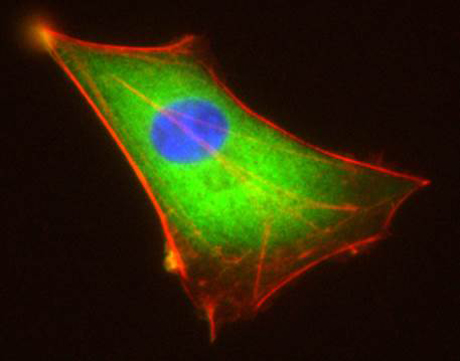Promising target found for better brain cancer drugs
By Carly Hodes

The deadliest brain cancer requires grueling treatment with bleak prospects for survival. Cornell researchers have discovered a key component to how these aggressive tumors grow that could lead to better solutions.
Published in the June issue of Cell Reports, their study opens a path for new drugs to block brain tumor growth with fewer side effects and lower resistance rates than most conventional cancer drugs.
Brain cancer kills more children under age 20 and men ages 20-39 than any other cancer besides leukemia, according to the National Cancer Institute. The most common and deadly form, glioblastoma multiforme (GBM), usually cannot be cured. These tumors grow rapidly, resist radiation and chemotherapy, recur after surgery and easily infiltrate normal tissue. Despite rigorous treatment, patients usually survive only 12 to 17 months after diagnosis.
“These tumors are extremely difficult to treat,” said Richard Cerione, the Goldwin Smith Professor of Pharmacology and Chemical Biology with dual appointments at Cornell’s Colleges of Arts and Sciences and of Veterinary Medicine. “The pressing need for new strategies to manage GBM led us to search for proteins future drugs could target to slow or stop this devastating cancer. We’ve found a promising candidate.”
That candidate, tissue transglutaminase (tTG), promotes growth and survival of several different types of cancer cells. It shows up in unusually large numbers in patients with lung and breast cancers. Analyzing GBM tissue and cell lines, Cerione’s new study found excessive tTGs in GBM cases. The worse the patient’s prognosis, his lab found, the more tTGs were in the brain.

Poor prognoses and too many tTGs also correlate with excessive numbers of the signaling molecule epidermal growth factor (EGF) receptor. These receptors stick out of cells like antennae, sending signals telling the cell to grow. Healthy cells keep tight control of those signals and can pull the antennae back inside, mark them for destruction, then form new ones when it’s time to grow again.
In many forms of cancer, including most GBMs, too many EGF receptors continue to send signals. Genetic mutations spur EGF receptor overgrowth in approximately one-third of GBM cases. In the rest, Cerione found that excessive tTGs interfered with the mechanism by which cells pull EGF receptors back into themselves and mark them for destruction.
“This has significant implications for brain cancer treatment,” said Cerione. “We found tTG is protecting EGF receptors, leaving too many out to send signals that spur brain cancer growth. Now we can look for ways to block tTG, which we believe is an unusually promising target for cancer drugs.”
Animals without the gene that makes tTG develop normally, Cerione says. Past studies suggest that in the absence of tTG, related proteins pick up its regular duties but don’t mimic its contributions to cancer.
“That gives us confidence we can target tTG without adverse effects,” said Cerione. “That’s cancer’s big challenge: Most drugs target a protein that allows cells to grow quickly. That may slow cancer, but it also affects normal cell growth, causing all sorts of side effects. Then the cancer cells find ways around it, likely because the drug interfered with a vital protein and cells always adapt to such losses. We hope that because tTG is dispensable, cells will be less pressured to develop resistance to drugs that handicap it.”
Given past evidence, Cerione says the new study suggests tTG may play a similar role in some breast cancers.
The study was funded, in part, by the National Institutes of Health.
Carly Hodes ’10, MBA ’15, is a communications specialist at the College of Veterinary Medicine.
Media Contact
Get Cornell news delivered right to your inbox.
Subscribe